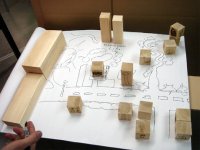Geo-Literacy Projects Build Students’ Understanding of Our Complex World
Your content has been saved!
Go to My Saved Content.If interdisciplinary project-based learning is a goal for you and your students this school year, you might want to start with questions that put a premium on place. For example: Where are bicycle accidents most likely to happen in your community? Where's the best spot to watch for migrating Monarch butterflies? What's the safest evacuation route in the event of a natural disaster? How have the neighborhoods of New Orleans changed after Hurricane Katrina?
To investigate such questions, students would need to gather and analyze data, look for patterns, think critically, and communicate their understanding with maps and other visual aids. In the process, they would also make connections across content areas and deepen their geo-literacy skills.
Maps and More
The ability to organize, visualize, and analyze information that relates to local and global issues is critical preparation for living in our connected and fast-changing world. Yet too few K-12 students have opportunities to develop these important thinking skills, according to a blue-ribbon panel that has charted a new road map for geography education. (Read an executive summary of the Road Map to 21st-Century-Geography Education.)
"To overgeneralize, location matters. That's the geographer's point of view," explains Robert Kolvoord. He's a professor at James Madison University and founder of the Geospatial Semester program, which is offered to high school seniors across Virginia.
Through the Geospatial Semester, students have investigated a wide range of issues with local and global consequences. For example: Where's the best location for offshore wind farms to maximize efficiency and minimize unsightliness? How might a terror threat affect local roads and public services? Where are the food deserts in our community?
Students not only investigate these interesting and timely questions but also develop solutions. "That means not only finding a problem worth solving but finding a problem that's solvable," based on available data, explains Kolvoord. Using technology tools, students then communicate their solutions in a way that's visually interesting and understandable to public audiences.
When students present their solutions -- typically, to a panel of experts -- "they get poked and prodded a bit," adds Kolvoord. The critical feedback "helps them anticipate what's coming [in college and careers]. They're moving out of a place where there's always one right answer." (Read more about the Geospatial Semester and other geo-literacy projects in Implementing Project-Based Learning.)
Benefits to Community
Geo-literacy projects often open the door to collaboration between classrooms and community partners.
In Montana, for example, students have mapped everything from water mains to manhole covers to bat habitats. Partnering with the local historical association, students in one community created detailed maps of a pioneer cemetery so that visitors can locate the graves of their ancestors. Such projects often have students working side-by-side with surveyors, scientists, and public works experts, and presenting their work to county commissioners and other decision makers.
Through such real-world experiences, "students are empowered by the fact that adults take their work seriously," says Kolvoord. At the same time, collaborations with experts help students appreciate "how professionals work and think."
Geo-Literacy Resources
A variety of resources are available to inspire and support geo-literacy projects. Here are just a few:
Story Maps: A platform for creating place-based narratives, Story Maps is likely to be a new kind of storytelling for most students. Before embarking on a project, you might explore featured examples with students. This will help them understand the qualities of a compelling story that conveys a strong sense of place with words, images, and maps.
EAST: The Environmental and Spatial Technology Initiative is a network of schools in several states that combine geospatial technologies with PBL for community service projects. In the past, EAST students have mapped national park trails and created multimedia story maps to document local history. Explore the project finder to read about recent examples.
Geo-Educator Community Resources: Geo-education resources, gathered by educators for educators, focus on environmental education, global collaboration, citizen science, and more.
GeoMentors: Need help getting started with geographic information system (GIS) technologies? GeoMentors connects industry volunteers with K-12 educators to enhance geographic learning and use of GIS tools in schools. GeoMentors is a collaborative effort of the Association of American Geographers and the Esri ConnectED initiative to bring ArcGIS Online to schools across the U.S.
